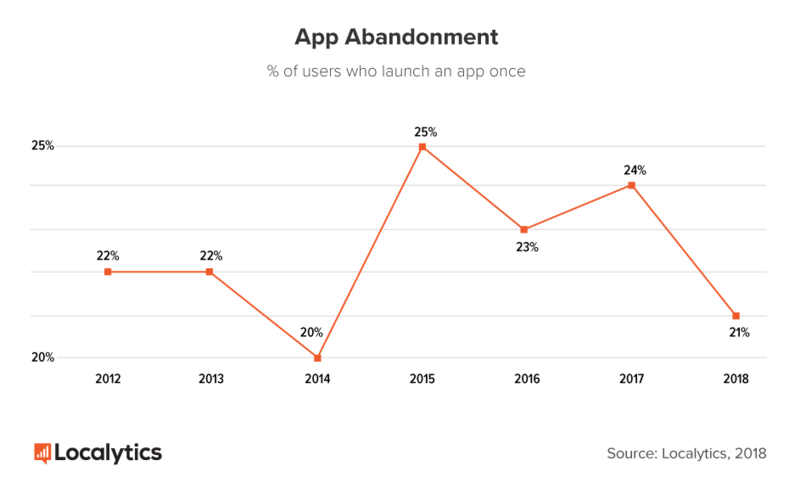The Ultimate Guide to Make Your App Available Offline
- Mobile
- July 6, 2020
These days, users want applications to perform even when they are not online. Else, a poor network connection gives a poor user experience. As per Localytics, 21% of users stop using an app after only one usage. Offline mode, in-app messaging, and push notifications help retain users.

It’s impossible to install or utilize an app if you don’t have an internet connection on your smartphone. Hence, you must develop an offline mobile app. It’s a growing trend and mobile app developers are taking lots of interest in building such applications.
What Are Offline Mobile Apps?
WhatsApp is the trendiest messaging app that people are using round-the-clock these days. The app works with an internet connection and you cannot send a message without the internet connection.
Thereby, offline apps are the applications that work even when your internet connection gets disconnected and you can resume the application, from where your connection is terminated.
Top Reasons to Develop an Offline Mobile Apps
There are many advantages to building an offline mobile app. The prime object of this app is creating a secure and trustworthy environment that is helpful for people of any age and any type like school and college people, homemakers, office persons, adults, and kids.
Building an offline mobile app or choosing the offline capacity will permit people to get a convenient mobile app experience when the connection is not working, flickering, slow, or low.
Top reasons to build an offline app for your business include:
- Due to an amazing feature, users will like your application and recommend it to others.
- Users will have a great mobile experience even if they are not in a good network area.
- You can be connected using this app even if you are traveling.
- Customers will rely on it as the app can be used immediately with no specific condition.
- Effective medical services will be offered in rural areas where no internet connection is available.
- Offline app service helps have complete control of the caching procedure.
- Often, the entire procedure of data storage on the server needs a strong connection. Hence, using an offline saving option, you can make changes when required.
- You can handle all your company activities with complete flexibility using an offline mobile app.
Top Benefits of Using an Offline Mobile App
Poor internet connection can result in bad user experience. Applications with improper UX are annoying and many users may just uninstall them.
Here are a few benefits of using an offline mobile app that will boost user experience and help your business get the utmost profits:
1. Get an Edge on the Competition
Every app has at least one competitor now as the app market is very big. Consider Facebook and WhatsApp Messenger, or Lyft, and Uber. People generally select apps depending on some factors.
Some people choose for a better performance whereas others prefer incredible design. However, what if your rival launches an online app while your app is offline? You have a better scope of winning over the competition in no-network areas.
2. Poor Connectivity Will Not Annoy Users
If you develop an offline mobile app, it can be used in the areas of poor connectivity. Ensure to ponder where your possible users will be amid the day.
Ask yourself whether your app users are staying in a place with restricted data or Wi-Fi connection. If so, developing an offline app can increase your user retention and acquisition rates.
3. Acquire More Loyalty from Users
When users know that your app is reliable in the areas of poor connectivity, they will become more loyal.
4. No Roaming Expense While Travelling
When you go abroad, some apps require a lot of costs for accessing the large data network. It can be costly as using an offline app lets you access it at no cost.
5. Fast Loading Time
Offline mobile apps are not just advantageous for saving data or money but also come with lots of features. They offer quick loading time even if the connection is poor and they offer organized access to all app features.
6. Save Your Device’s Battery
This is the most useful advantage of an offline mobile app. It saves your phone’s battery that generally gets used more when you travel and your mobile turns off when you are about to reach the place. Using an offline app lets you avoid this condition.
Tips To Choose Offline Features For an App
There is no magical method to build a perfect offline mode for your app. You must do your homework. Here are some tips to help you:
- Assess your workflow, decide your business requirements, and translate them into application features.
- Give these features priority as once they become important for your business, they become urgent.
- Determine what you need to accomplish through your application. Share this data with your developers. Let them understand your business objects and recommend precise technologies for a custom solution.
You can use the popular Eisenhower Decision Matrix for choosing offline functions. It will help you see what is necessitous and what is not. Using this matrix, you can have lots of offline features and analyze how to execute them.
Tips To Select Technologies for Offline Mode
The technologies you choose will have a massive impact on your app’s offline mode performance. Ponder the following while choosing technologies:
1. Cycles and Time of Data Synchronization
Data must be prioritized as per business requirements. Some data needs to be updated once every year, whereas others require being updated a few times a day. You can decide various synchronization cycles for various data as per business needs.
Smaller data packages need high-frequency updates. Your app may not require continuous data synchronization. If it needs, you can sync data at a particular time.
2. The Regularity of Data Synchronization
Reconnecting frequently might drain a mobile’s battery. However, if your app synchronizes infrequently, users might miss necessitous updates. To find a balance, work with your developers.
You will need to check how frequently your users can use high-speed internet. In case people utilize your app for work, decide which slots are good for downloading data in their work schedules. If the data connection is better, those slots can be shorter.
3. Managing Sensitive Data
Private user info cannot be erased for security purposes. Downloaded data like blog posts and logos are stored in a cache folder on the user device, so it doesn’t require being downloaded every time the user uses that content.
By pushing the Back button of the browser or checking the cache of the browser, cached info can be viewed. This puts sensitive data like usernames and credit card details at risk. Hence, ensure sensitive info is not cached.
4. Handling Changes in Shared Data
In case some users are not online, changes in data cannot be accessible to others. Thereby, many users may work on similar info without checking how others have changed it.
In case you cannot ignore such a scenario, concentrate on exception managing and deciding rules for how to handle those exceptions.
5. Ways of Syncing
To choose the most precise technologies for your offline mode, check whether data transfer should be synchronous or asynchronous, whether data will be synced manually or automatically, whether the app will ask the server actively for updates or the server will send new data itself to the app.
How to Apply Offline Mode for Mobile and Web
There are some distinctions between applying offline mode for mobile and web. Let’s check how to store and synchronize data for both mobile and web apps!
Storing Data Offline for Mobile and Web
Web apps store data in the browser whereas mobile apps store them locally. Prime tools for storing data in the browser include:
1. ServiceWorkers
It works as client-side proxies. It can take requests away from clients. ServiceWorkers have a well-made lifecycle.
Google has made 2 amazing libraries – sw-toolbox and sw-precache – for caching dynamic and static content. You can use these libraries for applying your offline tactics.
2. IndexedDB
Offline web applications use offline storage APIs to receive data. IndexedDB provides a greater API than the Local Storage API to store data in the browser. You can use it or the same substitute for storing data offline.
Your app must not make any HTTP call so as not for failing in offline conditions. Browsers may clear IndexedDB in low-storage situations. To fix this problem, you can utilize the persistent storage API.
Creating an Offline Storage in iOS and Android
1. SharedPreferences
You can utilize SharedPreferences to develop an offline application for Android.
2. NSUserDefaults
You can use the NSUserDefaults calls for saving and updating users’ choices to apply offline mode for iOS apps. The NSUserDefaults class provides a programmable interface, enabling an app for tailoring its behavior as per a user’s choice. For example, you can allow users to save a profile image offline or include functionality that saves documents automatically.
The app tracks such choices in the user defaults system. This way, data is cached and helps you ignore opening the user defaults database when you require a default value.
Since this default system is accessible inside the app code, every piece of data saved to it will continue across app sessions. If a user resets his/her device or closes the app, he/she can still utilize the saved data the next time he/she enters the app.
3. Local Storage (Internal/External)
SharedPreferences approach is very restricting for storing images, consecutive objects, JSON, XML, and other files. You can utilize this method for such cases when you need to store data to the phone’s file system that does not need relational database capacities.
Internal or external data storage makes sure prompt data storage and is easy to use. Every data piece stored utilizing the internal storage process is private and secure to the application. The data is removed from the device in case the app is uninstalled.
4. SQLite Database
Both iOS and Android support the SQLite Databases. Every mobile platform offers its database handling tools. SQLite runs properly on mobiles and offers applications with the power and speed of a completely featured relational database.
SQLite utilizes one file for storing data. The SQLite Database cannot fix a lot on the sync and discord resolution side; nevertheless, it’s simple to use choice for caching or queuing data. In case you want to store data that should be queried, use the SQLite Database.
Making Sure Data Sync For Mobile and Web Apps
When you use an app offline, many actions and much data are there to sync with the server. This synchronization can occur when an internet connection is accessible. User actions can be stored in IndexedDB for web apps as jobs for syncing.
As early as the network is accessible, these tasks can be processed. Using a mobile app, you can have both server-side and client-side storage. Let’s have a look at the details of data syncing for mobile and web apps!
1. Offline Sync for a Mobile App
With an offline app, users can take offline actions and then sync transformations using a central warehouse. For doing this, your app will require handling the data flow between the client and the server. In maximum cases, offline mode is utilized in situations when users can edit data on the mobile and server-side.
This is the most incredible case scenario. Although it may be attractive to develop offline applications assisting two-way sync, it is the most complex method. In case you assist two-way sync, the logic of synchronization has to make sure that data is updated on the server and mobile sides at the same time.
2. Offline Sync for a Web App
When you preserve offline data in your browser, you need to upload it to the server when the network is accessible. To ensure proper data synchronization, do the following:
- Decide the smallest amount of data for storing locally.
- Choose as little data as possible to shift from the server to the device.
- Fix a trigger for starting the synchronization, in the background, or manually.
- Set up conflict resolution.
- Recognize and prioritize data sets for synchronization.
- Address the factors that will set up synchronization.
- Make a balance between the battery’s drain and sync frequency.
- Describe the retry mechanism.
- Send a notification of sync status to users.
Closure
Some apps can’t be built completely offline. Nevertheless, most of them can select to make at least a part of their data available without an internet connection. Enabling an app for working offline makes sure a better user experience, greater client loyalty, and a boost in the competition.
FAQs About Offline Mobile App
Nowadays, people are buying goods and services using smartphones but there are many areas with very little network coverage and even no coverage at all. So, to encounter such issues, the mobile app should have office mode.
There are three major types of offline apps like apps that store data offline, apps that allow a user to edit other user’s data, and apps where data can be edited offline but can be synched offline.
The cost to develop an app with offline mode depends on factors like features, design complexity, country of the development team, development platforms, testing, etc. Please send your app requirements to know the exact cost.













